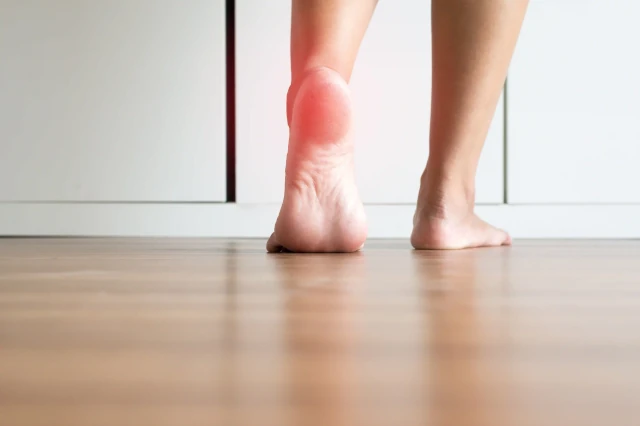
Plantar Fasciitis & Heel Pain: Causes, Symptoms, and Effective Treatments for Foot Pain Relief
- Dr. Prachi Saini (MPT)
Connect with our expert physiotherapist for personalized physiotherapy advice.
Plantar fasciitis is one of the most common causes of heel pain, affecting millions of people worldwide. It occurs when the plantar fascia, a thick band of tissue that runs across the bottom of your foot, becomes inflamed. This condition can lead to sharp, stabbing pain, especially in the morning or after long periods of standing. In this blog, we’ll explore the causes, symptoms, diagnosis, and treatment options for plantar fasciitis, with a focus on physiotherapy as an effective solution for relief.
What is Plantar Fasciitis?
Plantar fasciitis is the inflammation of the plantar fascia, a ligament that connects your heel bone to your toes. This ligament supports the arch of your foot and acts as a shock absorber. Repetitive strain or excessive pressure on this ligament can cause tiny tears, leading to inflammation and, eventually, plantar fasciitis.
Causes and Risk Factors of Plantar Fasciitis
Several factors can contribute to the development of plantar fasciitis. The most common causes and risk factors include:
- Overuse and Repetitive Stress:
Activities such as running, dancing, or long-distance walking place repetitive stress on the plantar fascia, leading to inflammation.
- Obesity:
Carrying excess weight puts added pressure on the heels, increasing the likelihood of spurs.
- Poor Footwear:
Wearing shoes without proper support, especially those with inadequate arch support or cushioning, can contribute to calcaneal spur development.
- Age:
Plantar fasciitis is more common in people between the ages of 40 and 60, as the tissues in the foot lose elasticity with age.
- Foot Structure:
People with flat feet or high arches are at a higher risk of developing heel spurs.
- Occupational Hazards:
Jobs that require standing or walking on hard surfaces for extended periods increase the risk of developing plantar fasciitis.
Symptoms of Plantar fasciitis
The most common symptom of plantar fasciitis is pain at the bottom of the heel, which may radiate along the arch of the foot. Other symptoms include:
- Sharp Pain:
A stabbing pain in the heel, especially after periods of inactivity such as getting out of bed in the morning.
- Worsening Pain:
Pain often intensifies after long periods of standing, walking, or physical activity, although it may decrease during the activity itself.
- Tenderness:
The area around the heel or arch may be tender to the touch.
- Stiffness:
The foot may feel stiff or tight, especially in the morning.
Diagnosis
A healthcare professional can diagnose plantar fasciitis through a physical examination and a review of your symptoms. They may press on different areas of your foot to identify the source of pain. In some cases, imaging tests like X-rays or ultrasounds may be used to rule out other conditions, such as stress fractures or bone spurs.
Treatment Options for Plantar Fasciitis
While plantar fasciitis can be painful, a variety of treatment options are available to manage symptoms and promote healing. Most cases improve with conservative treatments, but more severe cases may require additional intervention.
- Rest and Ice Therapy:
Reducing physical activity and applying ice packs to the affected area can help alleviate pain and inflammation.
- Medications:
Nonsteroidal anti-inflammatory drugs (NSAIDs) such as ibuprofen can be used to reduce pain and inflammation.
- Orthotics:
Custom shoe inserts or heel pads provide cushioning and support to reduce pressure on the heel.
- Stretching Exercises:
Stretching the calf muscles and plantar fascia helps relieve tension and can prevent further damage.
- Physiotherapy:
A structured physiotherapy program focuses on strengthening the muscles around the heel and improving overall foot biomechanics to reduce strain on the heel bone.
- Night Splints:
Wearing a night splint keeps the foot in a dorsiflexed position, which stretches the plantar fascia and Achilles tendon while you sleep.
Physiotherapy for Plantar Fasciitis
Physiotherapy plays a crucial role in managing plantar fasciitis by addressing the underlying causes and promoting recovery. A physiotherapist can develop a personalized treatment plan that focuses on stretching, strengthening, and improving foot mechanics.
- Stretching and Strengthening Exercises
Regular stretching exercises, especially for the Achilles tendon and plantar fascia, help reduce the tension that contributes to spur formation. Strengthening exercises for the foot, ankle, and calf muscles are essential for improving balance and reducing heel stress.
- Manual Therapy
Physiotherapists use techniques like deep tissue massage, joint mobilization, and soft tissue manipulation to alleviate muscle tightness and promote healing.
- Gait Training
Improving walking posture and correcting foot alignment are essential parts of physiotherapy. Gait training helps reduce pressure on the heel and distribute weight evenly across the foot.
- Stretching Exercises:
Stretching the calf muscles and plantar fascia helps relieve tension and can prevent further damage.
- Taping Techniques
Kinesiology taping provides support to the arch of the foot and reduces tension on the plantar fascia and heel bone.
Surgical Options
In severe cases where conservative treatment fails to alleviate pain, surgery may be considered. This involves removing the calcaneal spur and repairing any damage to surrounding tissues. However, surgery is typically the last resort and is only considered after a lengthy period of conservative management.
Prevention of Calcaneal Spur
To reduce the risk of developing calcaneal spurs, consider the following preventative measures:
- Wear Proper Footwear:
Invest in supportive shoes with good arch support and cushioning to reduce stress on your heels.
- Maintain a Healthy Weight:
Keeping your body weight in check reduces the pressure on your feet.
- Stretch Regularly:
Incorporate stretching exercises into your daily routine, especially if you’re involved in activities like running or standing for long periods.
- Modify Activities:
Avoid repetitive activities that strain the plantar fascia or increase your activity level gradually.
- Use Orthotics:
Custom orthotics can provide support and help distribute pressure evenly across your feet.
Conclusion
Plantar fasciitis is a painful condition that can significantly impact your mobility and quality of life. However, with proper care, including physiotherapy, stretching exercises, and supportive footwear, most people experience significant relief from their symptoms. If you’re suffering from persistent heel pain, consult a healthcare professional or physiotherapist to develop a personalized treatment plan.
Connect with our expert physiotherapist for personalized physiotherapy advice.



